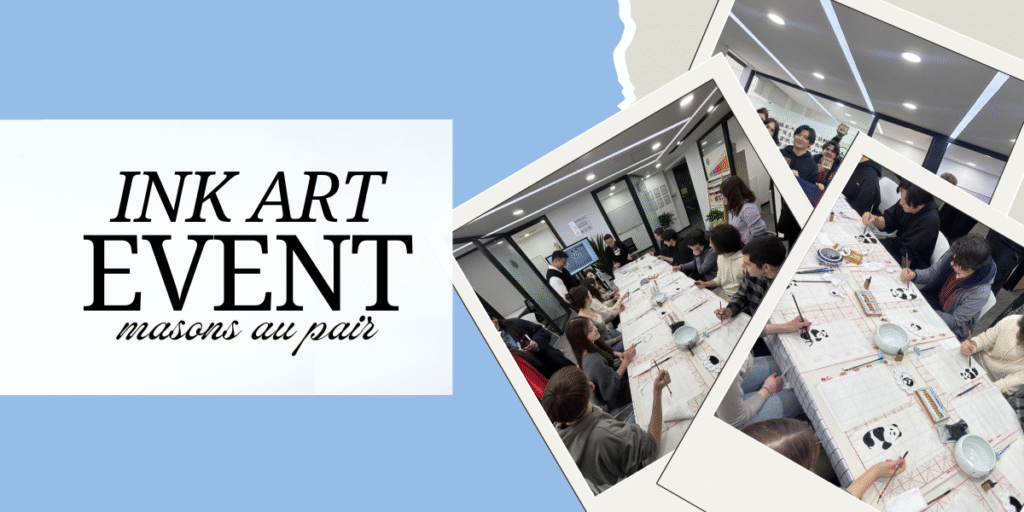At Masons Au Pair, we believe that becoming a Chinese au pair is far more than just travel or childcare—it’s a gateway to ancient Chinese traditions, artistic exploration, and genuine cultural exchange. Our au pair programs in China invite participants to step inside daily life, build real connections, and engage with the country’s rich heritage through unforgettable, hands-on experiences.
One such experience recently took place in Chengdu, a city renowned for its cultural vibrancy, museums of art, and connection to traditional practices. The highlight of this au pair event was a Chinese ink painting workshop, where participants were introduced to shuǐ mò huà (水墨画)—a respected art form practiced since the Tang, Song, and Qing dynasties. Historically favored by painters, emperors, and scholars, this technique uses deep black ink on Xuan paper to depict scenes such as landscapes, bamboo, plum blossoms, or animals like pandas, with both elegance and emotional restraint.
Our au pairs were guided by a professional Chinese artist, who introduced them to the Four Treasures of the Study: the brush, inkstone, rice paper, and ink stick. These tools, central to both calligraphy and painting, reflect the importance of simplicity, patience, and intention in East Asian art. The instructor also emphasized how to hold a Chinese brush, vary brush pressure, manage ink flow, and apply brush strokes with meditative precision.
Each participant learned how to paint using traditional methods such as ink wash, dry brushwork, and linework, often seen in figure painting or scrolls. They discovered how minimalist choices—like leaving space untouched—can be just as meaningful as what is drawn. While some focused on detail, others let instinct guide them, creating bold, expressive interpretations that mirrored their personalities.
For many of our au pairs, it was their first meaningful interaction with Asian art. This wasn’t just a class—it was a calm, focused, and deeply transformative moment. It revealed that to paint in the Chinese tradition means not just to depict, but to reflect. Through this art form, they saw how culture, philosophy, and creativity can blend seamlessly into a quiet yet powerful act of self-expression.
🖌️ Ink, Paper, and Stories: A Soft Entry into Chinese Aesthetics
Our Chinese ink painting workshop began with a calm yet meaningful introduction to the Four Treasures of the Study—the brush, ink stick, Xuan paper, and inkstone. These essential tools, used by generations of Chinese painters, scholars, and poets, form the heart of calligraphy and Chinese brush painting. Deeply rooted in Confucian discipline and Daoist philosophy, they symbolize a connection between the mind, the spirit, and the creative act.
Our instructor—a skilled Chinese artist and historian—did more than demonstrate technique. She revealed the symbolism behind each element. The Chinese brush, with its fine hairs, transforms motion into emotion. The inkstone, when slowly ground with water, embodies patience and focus. The rice paper, delicate yet powerful, responds intuitively to every brushstroke, recording not only lines but energy and intention. Such materials, once favored by emperors and landscape painters during the Song dynasty, have been preserved in temples, scrolls, and even museum of art collections throughout Chinese history.
For many of our Chinese au pairs, this was their first time learning to paint in this tradition. They explored different brush types and minimalist palettes, experienced the scent of raw ink, and tried classic techniques such as carving seals, blending watercolor washes, and outlining delicate floral forms like the plum blossom or bamboo—both major themes in ancient Chinese art.
What unfolded was more than an artistic lesson. It became a sensory and emotional dialogue—where cultural immersion occurred not through speech, but through shared motion and reflection. The tactile beauty of the tools, the fluid grace of the ink, and the thoughtful pace of the session created a rare stillness that brought cultures together—quietly and powerfully.
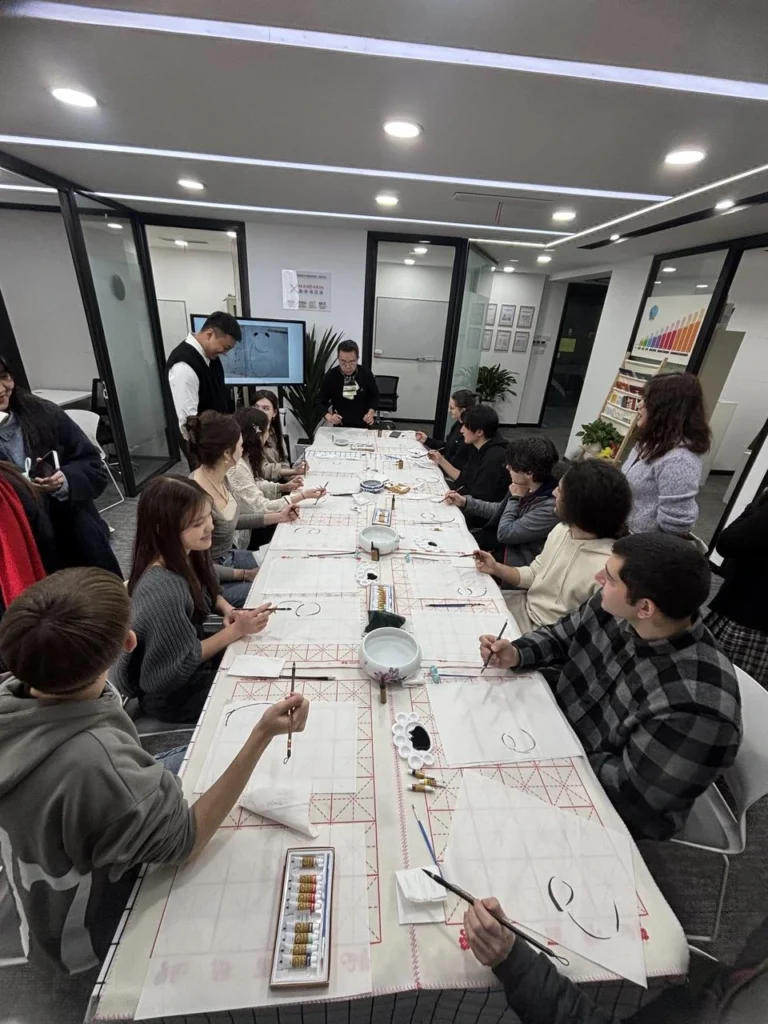
🐼 Let’s Paint a Panda – The Star of Chinese Culture!
The most anticipated part of our Chinese au pair event in Chengdu was the moment when participants began painting pandas using traditional Chinese brush painting techniques. This hands-on workshop wasn’t just an opportunity to paint—it was a window into the spiritual and aesthetic foundations of East Asian art, where every line carries emotional weight and philosophical meaning.
Guided by a professional Chinese painter and educator, our au pairs learned how to paint step by step using methods refined over centuries by Chinese artists from the Tang dynasty through the Qing dynasty. From how to grip a Chinese brush to managing ink pigments and varying brush pressure, each technique was taught with the intention of connecting hand, mind, and spirit. Participants practiced classic methods like dry brushwork, ink wash, and figure painting, all on absorbent Xuan paper, mirroring the textures seen in landscape scrolls and temple artworks.
But the essence of the session lay in its minimalist philosophy. The teacher encouraged students to embrace what traditional Chinese landscape painting teaches: that white space, or emptiness, is as vital as the ink itself. This dance between form and absence allowed the au pairs to express inner clarity and emotion through subtle choices and restrained gestures.
Each participant created their own panda artwork—a nod to one of China’s most cherished national symbols. In ancient art, the panda is more than a playful animal; it represents balance, peace, and harmony with nature. Through their individual styles—some soft and calligraphic, others bold and abstract—our au pairs transformed blank paper into vivid reflections of personality and cultural curiosity.
Whether they were complete beginners or art lovers, the experience transcended technique. It became a moment of cross-cultural connection, where painting served not just as a skill, but as a universal language. For anyone drawn to cultural immersion in China, this session beautifully illustrated how art can bridge continents, generations, and hearts.
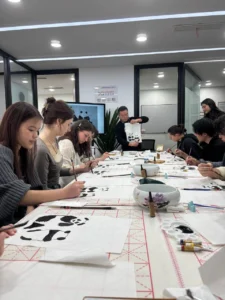
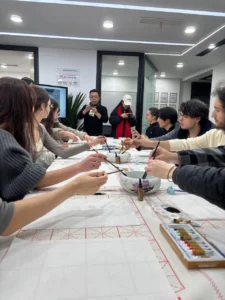
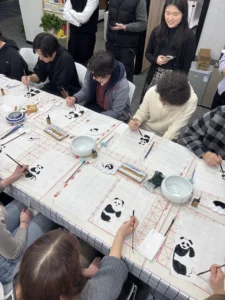
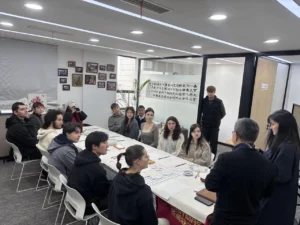
📸 Capturing Moments, Celebrating Creativity
After the final brushstrokes dried on the Xuan paper, our Chinese au pairs gathered around their teacher, proudly holding up their completed ink paintings for a group photo. The moment was filled with joy and a quiet sense of pride—laughter echoed, compliments were exchanged, and a shared feeling of accomplishment warmed the room. This gathering wasn’t just the end of a class; it was a celebration of creative expression and meaningful cross-cultural exchange.
To honor the occasion, each participant received a handcrafted gift: a small ink painting, signed in elegant calligraphic style using traditional characters and an artist’s personal seal. These delicate works, carefully mounted like miniature scrolls, were not only beautiful but symbolically rich—representing the patience, curiosity, and artistic humility that define Chinese brush painting traditions. Such gestures recall the historic customs of gifting artwork among dynasty-era scholars, artists, and collectors who understood that true beauty lies in simplicity.
Holding these unique pieces—crafted with Chinese brush, inkstone, and centuries-old knowledge—our au pairs were reminded that Chinese aesthetics often live in the subtle: in the plum blossom, the quiet autumn landscape, or the carved porcelain detail. Every stroke and every pause spoke to a legacy that stretches deep into Chinese history, blending visual storytelling with philosophy.
This gesture of giving brought the experience full circle: teacher and student, past and present, East and West—all connected through a single sheet of inked paper. Whether you’re studying abroad, exploring Chinese sculpture and painting, or living the daily life of an au pair in China, moments like this leave an impression that no photo can fully capture.
At Masons Au Pair, we create more than just activities—we build bridges between cultures through shared creativity, emotional presence, and the quiet power of art as memory.
🌏 More Than Just Painting: Real Culture Exchange
What our Chinese au pairs took away from this traditional Chinese ink painting workshop extended far beyond technique or how to paint a panda. This immersive, hands-on experience allowed participants to connect with Chinese culture in its purest form—not through sightseeing or lectures, but through feeling. Each brushstroke became a dialogue with centuries of Asian traditions, revealing cultural values like harmony, simplicity, and restraint.
Rooted in the philosophy of Chinese aesthetics, this art form teaches that beauty lies not in complexity, but in balance. Whether through brush strokes capturing the curve of a bamboo leaf or the suggestion of a misty mountain, traditional painting encourages the artist—beginner or master—to express emotion through subtle detail and intentional space. Mindfulness becomes an integral part of the creative process, as each gesture slows the mind and centers the soul.
The soft sound of brush on rice paper, the careful grinding of inkstone, the meditative repetition of watercolor wash—these quiet acts of creation offered more than art. They created stillness. Painting pandas evolved from a fun group activity into a peaceful, deeply personal encounter with one of the oldest painting techniques in the world. As one au pair reflected:
“I used to think Chinese painting was only for decoration. But now I see it as a kind of peaceful philosophy—a quiet, mindful practice. I felt so calm and focused.”
At Masons Au Pair, we strive to create experiences like this—where cultural immersion is felt as much as it is seen. Through artistic exploration, open hearts, and shared discovery, our au pairs gain more than cultural knowledge—they become part of a living tradition.
Whether you’re new to Chinese brush painting, curious about Chinese culture, or considering becoming an au pair in China, we welcome you to join us—ready to explore, reflect, and grow.

✅ Join Us for More!
Whether it’s painting pandas, practicing Kung Fu, or learning to cook traditional Chinese dumplings with a host family, life as a Chinese au pair with Masons Au Pair is about far more than childcare—it’s a transformative journey of cultural exchange. You’re not just visiting a new country; you’re stepping into the daily rhythm of Chinese culture, surrounded by local traditions, flavors, and ways of life that textbooks can’t teach.
Our goal isn’t just to offer travel in China—it’s to provide real, lasting cultural immersion. From exploring Chengdu markets to joining Asian art workshops, every activity we organize—from painting sessions to cultural field trips—is designed to help you connect with the people and stories behind the places. Even a simple moment like helping a host parent prepare dumplings becomes a chance to learn about history, values, and community.
Through this experience, you don’t just change where you are—you change who you are. You’ll strengthen your language skills, develop emotional intelligence, and build lifelong confidence. These are the moments that shape your global outlook, broaden your empathy, and help you grow into a true global citizen.
📸 Follow our journey for a closer look at life as a Chinese au pair—featuring authentic cultural experiences, student stories, and inspiration for your own adventure.
💡 Got an idea for your dream au pair activity? Whether it’s food, art, travel, or conversation—we’re always excited to co-create meaningful, hands-on experiences that bring people together through curiosity and creativity.

